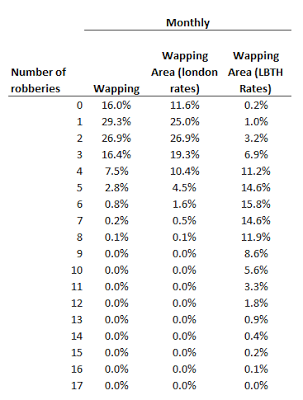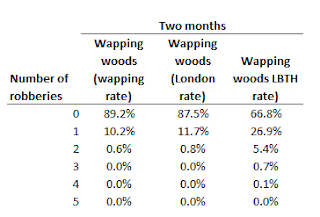In his response, LoveWapping quoted minutes from the Police Ward panel held on 24th April. There were two interesting nuggests of information.
The first:
"Robbery – there have been 2 robberies through Wapping Woods where an arrest has been made. Since the arrest there have been no more robberies in this area."It's not fully clear what period these two robberies occurred over but it seems likely to be March and April, based on other references to numbers of crimes in those months and the fact that the meetings appear to be every other month.
The second nugget was that:
"Wapping ward is in the top three safest places to live in London according to crime rates and ASB reported to the police."I am now pretty certain that this is not factually correct, unless there is some particular qualifying factor on the analysis, such as "2-4pm on that last wet wednesday, when the phone wasn't answered", and I think it's rather misleading - I discussed this claim in a previous post where I found the ward was actually the 402nd safest ward, not including ASB, in London. However, I have also written at length that safety is an emotion, or a feeling and not a statistic.
In my thoughts about crime and safety, I often return to Wapping Woods. Recently I've been walking through twice a day, to and from work. I've never felt unsafe or uncomfortable, but @potoft, my partner in crime (?) has been feeling increasingly uneasy. I noted recently to @potoft that as the trees become covered in leaves the light and the feel of the woods changes.
I have come to the conclusion that the woods are particularly ill designed given that there are both east-west and north-south pedestrian routes crossing through them. I don't know what would improve safety other than chopping the trees down, but I wondered if the Woods were actually any less safe than other parts of London, or Wapping.
The conclusion
Starting with the null hypothesis that crimes occur with equal likelihood in any given square metre of either Wapping, LBTH or London, the fact that two robberies occured in Wapping Woods in two months proves that this is not the case. I found that for the underlying number of robberies in Wapping, there is a 0.2% probability that two robberies would have occured in an area the size of Wapping Woods, suggesting that in those two months users of the Woods were statistically more exposed to the risk of robbery, or more specifically - we would not expect this level of crime purely at random, if crime was equally distributed. Only if our basis of analysis was using LBTH crime levels and we double the relative size of Wapping Woods is the finding not significant at the 95% confidence level. However, the police report suggests that this blip was due to one individual's actions. If this is the case, then a look at longer term levels of crime is necessary. I don't know if this will be forthcoming.In reality a myriad of factors interact to make crime more or less likely to occur in different places and I can't control for these. I know and accept that my analysis isn't fully robust, but it does approach the situation rationally and without emotion, it avoids anecdote and relies on facts. What it does tell me, is that more work needs to be undertaken by the police and community to reduce the dangers of this area.
The Boring Bit
For this analysis, I'm using the Poisson distribution, which expresses the probability of events occurring in a fixed period, independent of when the last event occurred. When the distribution is plotted, its a broadly bell shaped curve.Where this analysis differs from some I've done previously, is thinking about the probability of a given level of crime occurring in an area, rather than the number of crimes recorded.
So before we start. A few points:
- I'm looking only at robbery (ie theft from a person)
- I'm including robbery of both personal and business goods
- In the 24 months to March 2013, there were 71,536 robberies across London, or 2,980.7 per month
- In the same period there were 44 in St Kats and Wapping, or 1.83 per month.
- For all of LBTH the figures are 2,703 and 112.6
- The area of St Kats and Wapping is approximately 11.4 square kilometres
The first table shows the probability of a given number of robberies having occurred in a given month anywhere in St Kats and Wapping, based on a) number of robberies that occurred in St Kats & Wapping in the last 2 years b) the number that one might expect in Wapping if robberies occurred with equal frequency across all of London and c) the number in Wapping based on LBTH robberies. The final two calculations are based on geographic area, rather than the number of people (so if LBTH is 10 times the size of Wapping, I divided the LBTH figure by 10 to get the equivalent Wapping figure).
So based on Wapping's underlying number of robberies, there is an 84% (100%-16%) chance of at least one robbery. Using London and LBTH rates, this figure increases to 88.4% and 99.8% respectively. LBTH rates are considerably higher on the basis of geographic density of crime, which is likely linked to its much greater population density than Wapping and London as whole.
Looking at what we would expect from an area the size of Wapping Woods, I calculated the Woods to be around 18,000 square metres, or 0.02 square kilometres. Wapping is 1.14 square kilometres. Now assuming that crimes occur with equal frequency on any given bit of land, we can try and calculate what the probability of a robbery occurring in a piece of land of the area of Wapping Woods. What we find is that based on Wapping's number of robberies, is that there is a only a 2.8% probability of a robbery in Wapping Woods in a given month, but based on Tower Hamlets as a whole, the probability increases to 9.1%.
If we consider the likelihood of different numbers of robberies occurring over two months (which is what we have information for from the minutes), the probability of a larger number of robberies occurring, intuitively increases.
Similarly, looking at the Wapping Woods area, the likelihood of 2 or more robberies occuring in the Woods is between 0.2% and 1.8%. Clearly, the probability of two robberies occuring at random in an area the size of the Woods is very low, suggesting this isn't something that would happen by chance.
However, there are some flaws in my model - in real life I assume robbery is likely to occur outdoors rather than indoors (at which point it may become classed as burglary, other than in say shopping centres), whereas this model doesn't distinguish between relative areas of indoors/outdoors/private/public; therefore I acknowledge using a method based on total area without adjusting for buildings may distort results. To assess the sensitivity of my findings, I have doubled the estimated size of Wapping Woods to make it account for a greater proportion of the area of Wapping. However, even with this, assuming robberies occur with equal likelihood anywhere in Wapping, in a two month period, there is only a 0.6% probability that two or more robberies would have occurred in this period and even with the crime rate of LBTH, there is only a 6.2% probability of two or more robberies occurring in the Woods in this period. So at the 95% confidence level, this speight of robberies is not what we would expect in Wapping or London as a whole, but might be consistent with Tower Hamlets. If data was available for a longer period for the number of robberies in the Woods we would have a clearer idea. However, it seems that the Woods was certainly accounting for a disproportionate number of robberies in the area in those two months.










